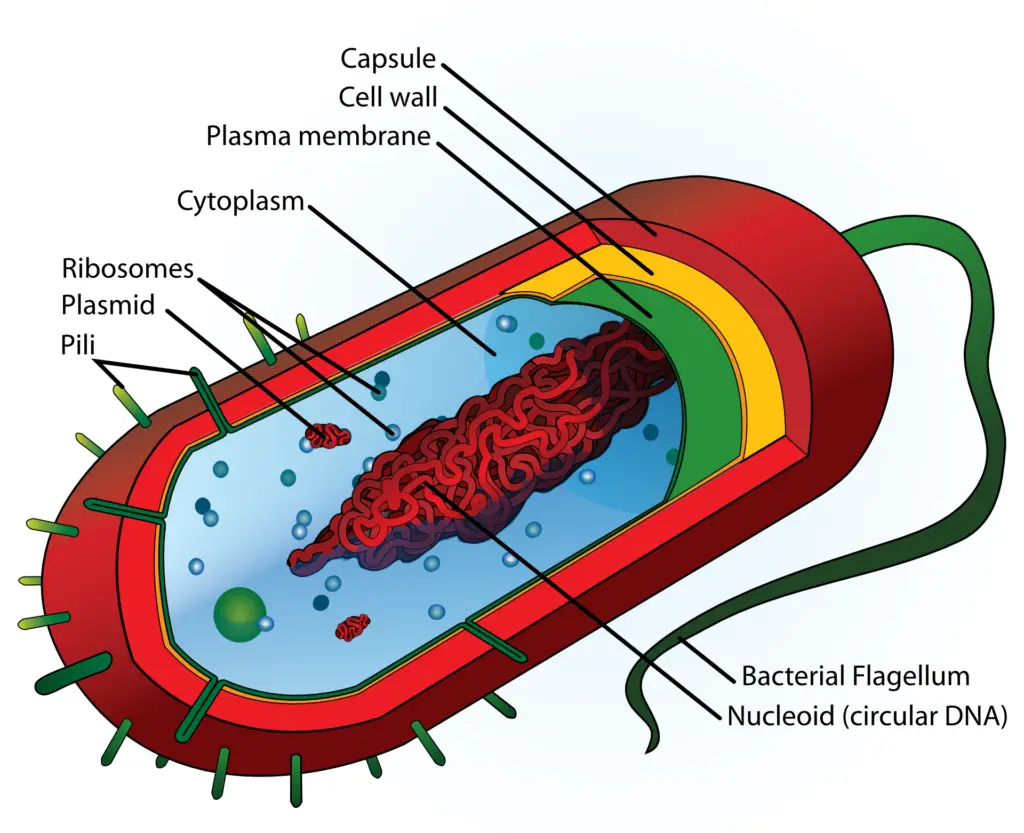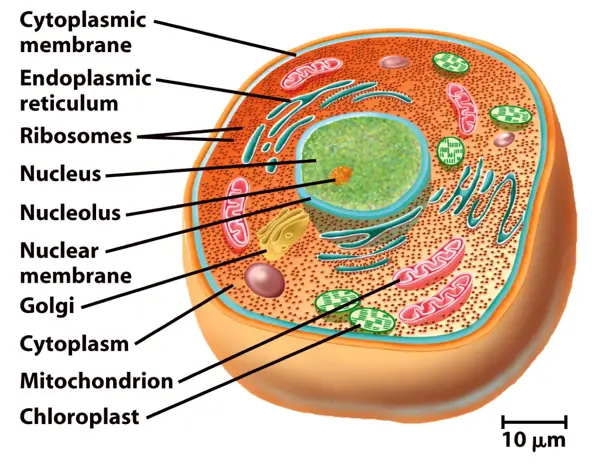Functions of Prokaryotic and Eukaryotic Cells
Here in this post, we will discuss the functions of the Prokaryotic and Eukaryotic Cells.
It’s obvious that every cell functions because of the working of the cell organelles that form the cell.
So, in this post we will discuss about the function of the various cell organelles and cell parts of both the prokaryotic cell and the eukaryotic cell so that you can know the function of the each type of cell.
One thing in common, we all know that the Prokaryotes are those organisms that possess the prokaryotic cell. These are unicellular organisms and do not have membrane-bound cell organelles.
On the other hand, Eukaryotes are those organisms that possess the Eukaryotic cells. These are multicellular organisms and have membrane-bound organelles.
So, without any further delay let’s dive more into detail about the functions of the Prokaryotic and Eukaryotic Cells.

Functions of Prokaryotic Cells
Single Circular Chromosome
1. Due to the presence of Singular Circular Chromosome, the DNA of the cell can very easily replicate in a very simple form without less use of energy and can easily pass to the daughter cells.
2. It carries a circular DNA molecule strand with no free ends to the DNA. This is so, it doesn’t create any significant challenges to cells with respect to DNA replication and stability.
3. Due to the easy genetic replication, rapid reproduction also occurs which provides an additional opportunity for various mutations that are responsible for genetic variability. Thus, it helps them to evolve rapidly to adjust with the environment.
4. Due to the lack of a nucleoid membrane, the circular chromosome’s haploid DNA can very directly communicate with the cytoplasm. This eventually lessens the time and energy used and thus allows a direct connection with the cytoplasm for proper transcription and translation.
Pilus & Flagellum
1. The pilus helps in the attachment of the bacterial cell to other bacterial cells or to the surrounding surfaces.
2. The Flagellum is used both as an organ of locomotion and movement as well as a sensory movement. The job of the flagella is like that of a motor boat’s propeller.
3. The short attachment pili help in the adhesion of the bacteria to the surface. This gives the bacteria its ability to firmly colonize environmental surfaces or cells and resist flushing.
4. Another important function of Pili is to transfer the DNA. There is a process called bacterial conjugation in which the conjugative pili functions to transferring the DNA contents between bacteria.
5. The flagella also act as sensory organs to detect temperature and pH changes. And, it also helps them increase the reproduction rate using a variety of mechanisms.
Cell Envelop
1. The outer layer of the cell envelope is the capsule made of glycocalyx which enables the bacteria to protect itself from engulfment by eukaryotic cells, such as macrophages by phagocytosis.
2. The outer capsule also allows the bacteria to provide means of locomotion, protect from host’s immune cells, adhere to surfaces, and gives protection from desiccation as well.
3. The cell wall is the next middle layer of the cell envelope and it is like a protective layer that surrounds the cells and gives them shape and rigidity.
4. The cell wall also protects the cell preventing osmotic lysis which is to protect the cell from bursting due to increasing volume inside it.
5. The plasma membrane is the inner layer of the cell envelope and its main function is to selectively allow the ions and organic molecules through it in and out, and regulate the movement of substances in and out of cells.
6. The plasma membrane controls the passage of organic molecules, ions, water, and oxygen into and out of the cell. Wastes such as carbon dioxide and ammonia are thrown out of the cell by passing through the plasma membrane, usually with some help of protein transporters.
Ribosomes
1. Ribosomes help during protein synthesis i.e translation. The mRNA attaches to the 30s subunit and the tRNA attaches to the 50s subunit thus leading to the formation of the proteins in the prokaryotes.
2. These are a crucial part of the various metabolic activities inside the cell such as repairing the damage of the cell or directing chemical processes inside the cell.
3. During translation, the ribosomes attach to the mRNA (messenger RNA) creating a polysome that eventually leads to the synthesis of a polypeptide chain.
4. During translation, the ribosomes again attach to the tRNA (transfer RNA) and joins together the amino acids polypeptide chain to synthesize the proteins.
Plasmids
1. Plasmids contain circular non-chromosomal DNA strand which contains antibiotic resistance genes, transgenes, and reporter genes which give additional genetic advantages to the prokaryotic bacterial cell. These types of plasmid genes may occur naturally or be engineered by scientists.
2. Plasmids carry those genes which are involved in metabolic activities and are also helpful in digesting the pollutants from the environment and protect the prokaryotic cell by creating antibiotic proteins.
3. Plasmids are also highly responsible for carrying the genes from a prokaryotic cell to another prokaryotic cell or from a prokaryotic cell to an eukaryotic cell in the form of pathogenic transfer.
4. Plasmids do also carry the tra-genes which are used in the process of conjugation. They are helpful in transferring the genetic material between bacteria.

Functions of Eukaryotic Cells
Endoplasmic Reticulum
1. Smooth Endoplasmic Reticulum is particularly indulged in the synthesis and secretion of the lipid molecules. The synthesis of phospholipids and cholesterol is the major function of the Smooth ER.
2. Rough Endoplasmic Reticulum is primarily involved in the synthesis, secretion, folding, modification, and transport of Protein molecules. They are involved in the synthesis and export of proteins and glycoproteins.
3. The Sarcoplasmic reticulum is a specialized type of SER that regulates calcium ion concentration in the cytoplasm of striated muscle cells.
4. The Rough Endoplasmic Reticulum can regulate the rate of process of translation from the mRNA and then tRNA. It functions by rapidly sending chemical signals to the nucleus when problems in protein synthesis and folding occur and thereby impact the overall rate of protein translation.
Ribosomes
1. Ribosomes can be seen floating within the cytoplasm or attached to the Rough Endoplasmic Reticulum. They function in the process of protein synthesis, repairing damage, or directing various cellular chemical processes.
2. Ribosomes help during protein synthesis i.e translation. It’s when the two subunits of ribosomes get bound to the messenger RNA (mRNA) polymer the proteins are synthesized with the help of transfer RNA (tRNA).
3. The proteins that are synthesized by the ribosomes present in the cytoplasm, are used in the cytoplasm itself. The proteins produced by the membrane-bound ribosomes like in the Rough ER, are transported outside the cell.
4. Ribosomes have the regulatory mechanism to detect what proteins the cell needs and how much it needs of a particular protein. It then attaches to the mRNA to read it, and takes the message to the corresponding tRNA and attaches the amino acid to the binding site.
Golgi Apparatus
1. Golgi Apparatus are the site of production of Glycolipids and Glycoproteins.
2. It is responsible for packaging proteins into vesicles prior to secretion and therefore plays a key role in the secretory pathway. It then also transports protein to the different parts of the cell.
3. It’s like that of the cell’s post office. And so, it’s one of the major function is the modifying, sorting, and packaging of proteins for secretion by the cell.
4. It is highly involved in the transport of lipids around the cell, and the creation of lysosomes for storing digestive enzymes and protein factors to destroy invading viruses and bacteria.
5. It is actively involved in carrying out the breakdown of proteins molecules and then leading to the formation of small, active fragments for various other metabolic uses.
6. In Golgi Apparatus, Polysaccharides are attached with proteins in order to form carbohydrates.
7. Sulfate groups are added to protein molecules in the Golgi apparatus as well.
Plasma Membrane
1. Cell protection from the external environment is the primary function of the plasma membrane.
2. The layer of the plasma membrane is composed of a phospholipid bilayer with various embedded proteins in it. It thus functions as being selectively permeable to ions and organic molecules and regulates the movement of substances in and out of cells respectively.
3. Passive, Active, and Osmosis transportation of molecules takes place in and out of the cell through the Plasma membrane only.
4. It’s non-permeable to ions, proteins, and other molecules, while permeable to other molecules that may move through the membrane.
Nucleus
1. The primary function of any cell’s nucleus is to control the process of gene expression and mediate the DNA replication process during the cell cycle stages.
2. The nucleus is the brain of the Eukaryotic cell. You can call it the CPU or motherboard of the cell as well. It genetically controls the main working and functioning of the whole cell and directly or directly maintains the other cell organelles as well.
3. Due to its double membrane-bound structure with small pores in its membrane, it allows the flow of proteins and ribosomes in and out of the nucleus to take place.
4. It is also responsible for protein synthesis, cell division, growth, and differentiation.
5. The nucleus is the site of DNA replication, transcription, and translation. Transcription majorly occurs in the nucleolus which is a dense, membrane-less structure composed of RNA and proteins inside the nucleus.
Mitochondria
1. The main work of the mitochondria is aerobic respiration and the generation of cellular energy. That is why it is also known as the Power House of the cell.
2. It is also responsible for regulating the metabolic activity of the cell.
3. Mitochondria also aid in promoting the process of cell multiplication and during the cell growth cycle as well. This organelle is also known for detoxicating ammonia in the liver cells.
4. It also plays an important role in apoptosis or programmed cell death.
5. The citric acid cycle, or Krebs cycle, takes place in the mitochondria. This cycle involves the oxidation of pyruvate, which comes from glucose, to form the molecule acetyl-CoA. Acetyl-CoA is in turn oxidized and ATP is produced which is the aerobic energy derived from respiration.
6. The number of mitochondria in a cell and the mitochondrial well-functioning highly impacts the rate of energy that the cell needs to produce for its working and also for supply to the body. For example– Muscle cells, have many mitochondria because they need to produce energy to move the body. Whereas, Red blood cells, which carry oxygen to other cells, have none of it.
Chromatin (DNA + Protiens)
1. Chromatin is the network of a complex of DNA and Proteins compactly packed together. Its main prominent function is packaging long DNA molecules into more compact, and denser structures.
2. It is actually due to the uncoiling and coiling of the compact Chromatin fibres that a number of cell processes can occur inside the cell including DNA replication, transcription, DNA repair, genetic recombination, and even cell division.
3. Chromatin fibers are coiled and condensed to form chromosomes. Each chromosome is made of protein and a single molecule of DNA that carries the genetic details of the cell. For example- Humans have 23 pairs of chromosomes, for a total of 46 chromosomes.
4. The chromosome contains genetic information for various cellular functions. These functions are essential for the growth, survival, and reproduction of the organisms.
5. Chromosomes protect the genetic material (DNA) from damage during the process of cell division due to the covering of histone proteins and other proteins cover the Chromosomes.
